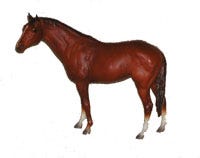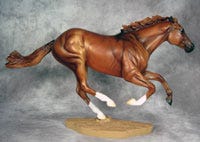From race time to cycle time
More than a mere model, for nearly 60 years Breyer horses have been sculpted, molded, and painted with such intricate detail as to capture the look and spirit of the actual horse. Here’s how they do it.
May 1, 2009
More than a mere model, for nearly 60 years Breyer horses have been sculpted, molded, and painted with such intricate detail as to capture the look and spirit of the actual horse. Here’s how they do it.
Spring has sprung, which for many horse enthusiasts means another shot at a Triple Crown champion—the greatest achievement in a three-year-old racehorse’s career. It can also mean—for a molder at Breyer Animal Creations, a division of toymaker Reeves International Inc. (Pequannock, NJ)—that a new legend will be made, literally, out of plastic.
|
Chicago-based Breyer Molding Co. started as a custom molder for the defense industry, but when the government gave it a pink slip in 1950 and an order came in to create a plastic horse, the 2000 models produced for that job changed the direction of the company forever. Horses, and eventually other animals, were made in Chicago until Reeves acquired Breyer in 1984 and production moved to New Jersey.
Through the years, one particular mold might produce a chestnut-colored horse, and a few years later a spotted Appaloosa, so creation and maintenance of these molds are essential to the company’s continued success.
Stephanie Macejko, VP marketing and product development for Breyer, explains how the models are made from concept to completion. Independent, freelance sculptors create models in clay, prototypes are cast in resin, and a pattern maker marks up the model to figure out how to cast the mold in steel. “Once the pattern maker returns the model after markup, we can see the proposed glue line. If parts of the sculpture are undercut, a cam, slider, or lifter is indicated as well,” says Macejko. A moldmaking engineer and production engineer are consulted to determine what needs to be done.
As for material, since 1950 the Traditional Series 1:9 scale model has always been in cellulose acetate. Macejko explains that it’s a warmer material, not tinny or brittle, and also that some collectors choose to customize models by heating and bending.
After the two halves of the model are injection molded in about a 1-minute cycle and the sprues are snipped, a minute of cooling time is essential for keeping legs straight. A press fixture bonds the two halves, and the cooled horses go to a buffing and scraping area, where they are prepped for painting. Each model goes through the hands of about 20 people, some airbrushing larger shades of color, and some hand painting details like the whites of the eyes.
From sculpture to production, the process takes around eight months, and each year about four to six new molds are produced. Around six years ago, the majority of production was moved overseas, where about 3 million models are made every year.
Each mold has a specific set of processing instructions to keep defects at a minimum. “It is amazing that close to 90-95% of our tool base is still viable. Of course, the maintenance of the tool is key,” says Macejko. “Understanding that each horse and mold is different, the skill of the molding manager is very important.” —[email protected]
Author’s note: It was these model horses that sparked my initial interest in plastics. The time I spent as a young girl softening and reshaping horses with a heat gun in the garage was just part of a hobby at the time, but it opened my eyes to how things are made out of plastic.
About the Author(s)
You May Also Like




